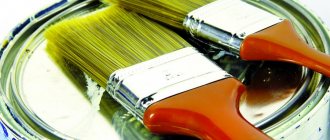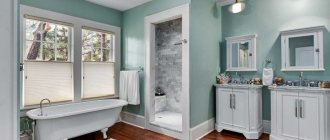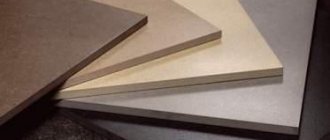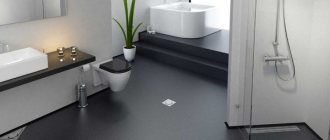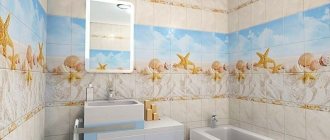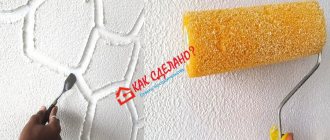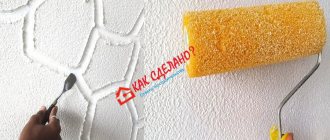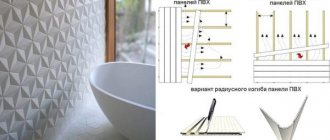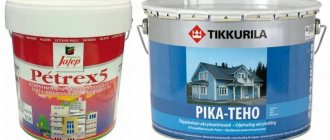Water-repellent paint is available for sale in a large assortment; if the conditions in the room are characterized by high humidity, then you need to choose just such an option. But among the variety of types, it is difficult for a beginner to make a choice, so you should at least have a minimal understanding of the features of different types of paints. This will be discussed in detail below.
Which rooms are considered wet?
There is a fairly wide list of rooms that are classified as high humidity levels. This includes:
- Hallway;
- Bathroom, shower area;
- Toilet;
- Kitchen;
- Bath;
- Room with a swimming pool.
Choosing paint for these rooms is not easy; the following points must be taken into account:
- Frequent surface cleaning and repair work is required;
- Condensation accumulates here, moisture is constantly present, so the use of moisture-resistant paint for walls is simply a must;
- Resistance to abrasion and dirt is required;
- Eco-friendly composition and non-flammability.
Condensation accumulates here, moisture is constantly present, so the use of moisture-resistant paint for walls is simply a must.
General information
Waterproof paint for wood comes in a variety of types; it may differ in composition, appearance, some properties, etc. However, they are all united by one main quality - resistance to moisture. Even with direct contact with water, these compositions retain their properties.
When choosing a waterproof paint coating, you need to pay attention to the following qualities:
- Environmental friendliness - compositions during the process of application and hardening can release toxins, or be absolutely harmless;
- Drying speed can range from several hours to several days.
- Appearance – can be glossy or matte.
- Durability - depends on the composition and quality of the paintwork.
Taking these parameters into account, you can choose the most suitable paintwork for certain cases.
In the photo - acrylic paint on wood
What surfaces should be painted?
Waterproof paint is not applied to all surfaces in such rooms. Since not all materials require such protection. An overview of some reasons for the need for paint protection:
- Glass, previously, with the help of a paint and varnish material, an overlap of the transparency of the material was created in order to hide from view what was happening behind the glass. Now the optimal choice is to choose a matte look with an opaque structure or stained glass;
- Metal requires protection from moisture to prevent corrosion. There are processed types of metal products already during production that do not need to be painted additionally, for example, with chrome, stainless steel, and some non-ferrous metals;
- Plastic does not need protection from moisture, and painting is difficult due to poor adhesion to the base. If you need to paint plastic, then first create roughness on the surface using sandpaper;
- The foam surface is usually covered with other finishing materials on top, so do not paint it. But if there is no barrier installed on the outside, then you can paint the foam, but using means that are harmless to it, without thinners;
- Water-repellent paint for wood or plywood can be painted, but usually the protective barrier is made of varnishes or stains;
- Concrete, as standard in an apartment, is covered with other materials with better decorative properties. The base is painted only in warehouses and production areas, where aesthetics are not so important.
There are types of metal products that are processed already during production, which do not need to be painted additionally.
Matte
For painting bathrooms where there are minor defects on the surfaces, matte compositions are an excellent option.
Quick-drying, odorless paint for interior work - main types, selection tips and benefits of useThe best aerosol paint in cans - main types, application features and advantages of use
The best water-based paint - ranking of the best manufacturers of 2018
However, before choosing this type of paint, you need to think carefully about everything, since even the slightest dirt is noticeable on such coatings; it will not be possible to remove them with a damp cloth, therefore, there is a need to repaint the surface.
Therefore, in order to decide which paint for the bathroom is better, it is necessary to study all the technical and operational characteristics, properties, and scope of application. Of course, you should buy paint only in specialized retail outlets to avoid counterfeit and low-quality products.
Review of moisture-resistant paints
Moisture-resistant paint is produced in different components, and the level of resistance to water also varies. Therefore, the choice must be made taking into account these characteristics of the species.
Moisture-resistant paint is produced in different components, and the level of resistance to water also varies.
Alkyd enamels
The best option for rooms with high humidity levels. A film-like coating is created that does not allow moisture to pass further. When applying several layers, the coating can be washed. However, the product emits a pungent odor, so it is necessary to wear a respirator and create good ventilation when working.
The best option for rooms with high humidity levels.
Water-based paint
Water-based emulsion paint does not have a high level of resistance to water. For this reason, it is often chosen for less humid rooms, for example, children's rooms, living rooms. Water-based emulsion can be used on the ceiling; splashes on it are less likely.
Such unreliable protection from water is associated with the production of a porous coating. Over time, they will begin to become saturated with moisture.
Water-based emulsion paint does not have a high level of resistance to water.
Acrylic paint
This type is more resistant to water than the previous one; it can be used for the kitchen and toilet, but for the bathroom it is not the best option. The protective barrier does not last long if such increased loads are placed on the acrylic layer. Mold and mildew may also form on the surface; to reduce the risk of such problems, anti-mold substances are added to the composition.
If you apply several layers, the paint can be washed, but not as often as a product with an alkyd base.
The protective barrier does not last long if such increased loads are placed on the acrylic layer.
Silicone pigment dyes
Silicone-based products perform well in humidity. They also allow air to pass through, which helps maintain an optimal microclimate. They can be washed.
The paint is resistant to ultraviolet rays, which allows color saturation to be maintained even longer. However, their cost is high.
Silicone-based products perform well in humidity.
How to work with finishing material
High-quality cladding depends not only on the paint chosen, but also on the work done.
If you follow all the recommendations, the design will turn out beautiful and practical. Start with surface preparation. The old coating needs to be removed. Eliminate all irregularities, cracks and other defects. The surface must be flat so that the applied composition does not expose all the imperfections of the walls. There should be no roughness. Additionally, the surface should be primed to increase adhesion between the paint and the wall. It is important to carefully calculate the amount of material needed. You need to take into account not only the area of the surface to be painted, but also the tools used.
Brushes and rollers waste more composition than special sprayers.
The surface should be primed to increase adhesion between the paint and the wall.
Dyeing process
Many manufacturers produce ready-made formulations. They do not need to be mixed. Can be applied directly to the surface
It is important to properly store the paint before use and prevent it from freezing. Otherwise, it will take time until the composition takes on its normal appearance.
In some situations, it is not possible to restore the previous appearance and desired properties of the paint. It cannot be used.
Before applying the composition to the wall, it is recommended to mix it. If you need to get a thin layer, it is recommended to add a small amount of water and mix again. Several layers of paint are usually applied to the walls. Before applying the composition again, you must wait until the previous one has dried.
You should choose tools taking into account the effect you want to achieve. Different lengths of pile on the roller allow you to get different designs. For hard-to-reach places, use a brush.
Start painting from the top and move down. To make sure that the result is satisfactory, it is recommended to first coat a small area of the surface with the selected composition and let it dry. If you like the resulting color and effect, you should start covering the entire wall.
Different lengths of pile on the roller allow you to get different designs.
For walls
The paints listed above are suitable for covering walls. In addition to the type, it is important to choose the right color of the dye. Many compositions are presented in a wide variety of shades, so you can choose any option to suit the interior of the room.
The coatings may differ in the resulting effect - matte or glossy. For the ceiling, a white, super-white shade is usually chosen, which allows you to visually lengthen the space. Moisture-resistant paint for walls is selected to match the style of the room, and taking into account the combination with furniture.
For interior work, the safety of the composition for human health is necessary.
Many compositions are presented in a wide variety of shades, so you can choose any option to suit the interior of the room.
Silicone coatings
Such products are a very good answer to the question of how to paint the walls in the bathroom or the ceiling. Silicone compounds are currently a relatively new type of paint and varnish on the Russian market. Paints of this type are characterized by increased moisture resistance. They cost more than alkyd enamels, but they can last longer. If desired, walls painted using silicone coatings can subsequently be safely washed with ordinary household chemicals.
It is advisable to use such paints, including for wet rooms, because they can not fade in the sun for a long time. Therefore, products of this variety are simply ideal for decorating kitchens with windows facing even the south side.
For wood
If you decide to create moisture protection for wooden surfaces using paints, you usually choose from the following types:
- Water-dispersed;
- Alkyd;
- Polyurethane;
- Oily ones.
If you decide to create moisture protection for wooden surfaces using paints, then you usually choose from water-dispersed, alkyd, polyurethane, and oil-based ones.
Professional painting
Our specialists have extensive experience in painting any wooden surfaces. We know all the nuances of working with wood, we have the necessary equipment and materials. We use professional paints and varnishes that are ideal for painting wet rooms. Craftsmen will complete all stages of bathroom painting work in a short time and at a high level of quality. You will find our coordinates in the “Contacts” section; you can contact us in any convenient way.
Calculate the cost of painting and insulating your home right now
Select types of work:
Select materials:
Advantages and disadvantages of moisture-resistant paints
Waterproof paint for working on surfaces in different rooms has the following advantages:
- Durability;
- For a room with a high level of humidity they are optimal;
- By creating a barrier against water, the durability of the plaster layer and drywall is extended.
But there are also disadvantages to coloring:
- It will be necessary to create a perfectly leveled base, because the layer emphasizes even minor flaws;
- Mechanical loads easily destroy the beauty of the coating;
- Typically, the compositions are not vapor-permeable, so biological formations may appear, and the microclimate in the room will not be the best. For this reason, it is necessary to take care of separate ventilation.
They are optimal for a room with high humidity levels.
Oil paints
Once upon a time, such paints for wet rooms were used very often in our country. Nowadays, such compositions are practically not used in residential buildings. Oil dyes are used today mainly only for the design of various kinds of structures on the street (gazebos, fences, terraces, etc.).
The main disadvantage of oil-based paints is the very unpleasant odor when used. When decorating surfaces, such paints smell even worse than enamels. At the same time, they dry for quite a long time.
Another disadvantage of oil paints is that they create an absolutely vapor-proof film on the surface. Therefore, they are not very suitable for the bathroom either. The walls in such rooms must “breathe”.
The advantages of paintwork materials of this type include, first of all, low cost. Of all the types of paints discussed above, oil paint is the cheapest.
Oil-based paints and varnishes are usually used in bathrooms only for finishing concrete floors. Thus, this remedy, for example, is often used in old apartments in Khrushchev-era buildings.
Technology of applying waterproof paint to the surface
It is required to begin work by preparing the base. The surface must be well leveled, otherwise defects will be very noticeable after painting. All types of contaminants are removed. A primer must be applied to increase adhesion and provide better protection.
To apply the product, you can choose brushes, rollers or sprayers. Brushes are used only for hard-to-reach areas; treating the entire surface with them will take too long.
Rollers are the best option; the paint is distributed evenly and quickly. The spray gun helps you achieve a beautiful finish, but it requires experience to use. Also, the instrument itself is more expensive than others.
The surface must be well leveled, otherwise defects will be very noticeable after painting.
Leading manufacturers of moisture-resistant paints
Knowing the popular brands that produce high-quality paints for rooms with high humidity levels will make it easier to choose an option for yourself. The following brands can be distinguished:
- Tikkurila;
- Dulux;
- Dufa;
- Jobi;
- Caparol;
- Tex, Pro and Universal paints.
Knowing the popular brands that produce high-quality paints for rooms with high humidity levels will make it easier to choose an option for yourself.
Painting surfaces in rooms where humidity is high can be a budget option for finishing work. But it is important to choose the paint correctly so that it meets the necessary parameters. You will also need to carefully prepare the base, then the paint layer will look beautiful. The article discussed possible options.
